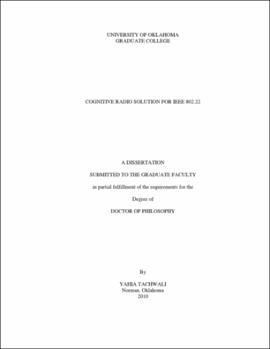| dc.contributor.advisor | Refai, Hazem | |
| dc.creator | Tachwali, Yahia | |
| dc.date.accessioned | 2019-04-27T21:27:08Z | |
| dc.date.available | 2019-04-27T21:27:08Z | |
| dc.date.issued | 2010 | |
| dc.identifier | 99204272802042 | |
| dc.identifier.uri | https://hdl.handle.net/11244/318717 | |
| dc.description.abstract | Current wireless systems suffer severe radio spectrum underutilization due to a number of problematic issues, including wasteful static spectrum allocations; fixed radio functionalities and architectures; and limited cooperation between network nodes. A significant number of research efforts aim to find alternative solutions to improve spectrum utilization. Cognitive radio based on software radio technology is one such novel approach, and the impending IEEE 802.22 air interface standard is the first based on such an approach. This standard aims to provide wireless services in wireless regional area network using TV spectrum white spaces. The cognitive radio devices employed feature two fundamental capabilities, namely supporting multiple modulations and data-rates based on wireless channel conditions and sensing a wireless spectrum. Spectrum sensing is a critical functionality with high computational complexity. Although the standard does not specify a spectrum sensing method, the sensing operation has inherent timing and accuracy constraints. | |
| dc.description.abstract | This work proposes a framework for developing a cognitive radio system based on a small form factor software radio platform with limited memory resources and processing capabilities. The cognitive radio systems feature adaptive behavior based on wireless channel conditions and are compliant with the IEEE 802.22 sensing constraints. The resource limitations on implementation platforms post a variety of challenges to transceiver configurability and spectrum sensing. Overcoming these fundamental features on small form factors paves the way for portable cognitive radio devices and extends the range of cognitive radio applications. | |
| dc.description.abstract | Several techniques are proposed to overcome resource limitation on a small form factor software radio platform based on a hybrid processing architecture comprised of a digital signal processor and a field programmable gate array. Hardware reuse and task partitioning over a number of processing devices are among the techniques used to realize a configurable radio transceiver that supports several communication modes, including modulations and data rates. In particular, these techniques are applied to build configurable modulation architecture and a configurable synchronization. A mode-switching architecture based on circular buffers is proposed to facilitate a reliable transitioning between different communication modes. | |
| dc.description.abstract | The feasibility of efficient spectrum sensing based on a compressive sampling technique called "Fast Fourier Sampling" is examined. The configuration parameters are analyzed mathematically, and performance is evaluated using computer simulations for local spectrum sensing applications. The work proposed herein features a cooperative Fast Fourier sampling scheme to extend the narrowband and wideband sensing performance of this compressive sensing technique. | |
| dc.description.abstract | The précis of this dissertation establishes the foundation of efficient cognitive radio implementation on small form factor software radio of hybrid processing architecture. | |
| dc.format.extent | 257 pages | |
| dc.format.medium | application.pdf | |
| dc.language | en_US | |
| dc.relation.requires | Adobe Acrobat Reader | |
| dc.subject | Cognitive radio networks | |
| dc.subject | Wireless communication systems | |
| dc.title | COGNITIVE RADIO SOLUTION FOR IEEE 802.22 | |
| dc.type | text | |
| dc.type | document | |
| dc.thesis.degree | Ph.D. | |
| ou.group | College of Engineering::School of Electrical and Computer Engineering | |
